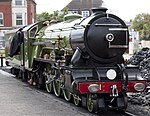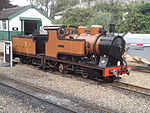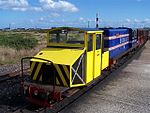Romney, Hythe and Dymchurch Railway
| Romney, Hythe and Dymchurch Railway (RH&DR) | |||||||||||||||||||||||||||||||||||||||||||||||||||||||||||||||||
|---|---|---|---|---|---|---|---|---|---|---|---|---|---|---|---|---|---|---|---|---|---|---|---|---|---|---|---|---|---|---|---|---|---|---|---|---|---|---|---|---|---|---|---|---|---|---|---|---|---|---|---|---|---|---|---|---|---|---|---|---|---|---|---|---|---|
|
A RH&DR train at Dungeness
| |||||||||||||||||||||||||||||||||||||||||||||||||||||||||||||||||
| Route length: | 21.7 km | ||||||||||||||||||||||||||||||||||||||||||||||||||||||||||||||||
| Gauge : | 381 mm ( Liliputbahn ) | ||||||||||||||||||||||||||||||||||||||||||||||||||||||||||||||||
|
|||||||||||||||||||||||||||||||||||||||||||||||||||||||||||||||||
The Romney, Hythe and Dymchurch Railway ( RH & DR ) is a 21.7 km (13.5 miles) long, in a track width of 381 millimeters (15 inches ) running railway southern England . It leads from Hythe , one of the Cinque Ports , via Dymchurch and New Romney to Dungeness . Despite the small gauge, the Liliputbahn is used by public transport all year round. It is not a park railway and does not see itself as a museum railway .
history
Originally, the idea of building a 15-inch railroad for public transport came from two wealthy British gentlemen and railroad fans . Count Louis Zborowski and Captain JEP Howey both owned Liliput railways with 381 mm gauge on their private country estates and decided to build and operate a line for public transport based on these models. Initially, they wanted to purchase the Ravenglass and Eskdale Railway , but unsuccessfully. Then both decided to build a new line from scratch and started looking for a suitable area. Count Zborowski had already ordered two locomotives for this. However, he had a fatal accident in a car race in 1924 and Howey pursued the joint plans on his own. He finally found suitable terrain in the flat marshland on the coast around New Romney, southwest of Folkestone . To build it, Howey founded the Romney, Hythe & Dymchurch Railway Company . Construction began in January 1926 between Hythe and New Romney, and the opening took place on July 16, 1927. The construction of the line attracted a lot of public attention, including the later King George VI. during construction on August 5, 1926, the route and drove with the first official train on an already completed section. Plans to extend the route from Hythe to Sandling station and thus establish a connection to the network of the Southern Railway were not pursued due to the considerable inclines required for this. Howey decided to instead extend the route from New Romney to Dungeness. The extension was opened in 1928, and like the first section, it was built with two tracks. Howey procured nine steam locomotives, seven Pacifics (2'C1 'wheel arrangement) and two Mountains (2'D1') for the operation. The latter are the only steam locomotives ever used in Great Britain in public rail traffic with this wheel arrangement .
At the time of its opening, RH&DR was the world's smallest public railway and was therefore marketed as the “Smallest Public Railway in the World”. It was mainly used in summer by holidaymakers and bathers, but also by locals for their everyday transport needs. Howey also tried to use the railroad for freight traffic and in 1937 there was a short period of special fish transport from the port in Dungeness to Hythe. In the long run, however, only the internal freight traffic was retained, mainly with materials for route maintenance.
At the beginning of World War II , the British military took over the operation of the railway, as the beaches between Hythe and Dungeness were considered one of the possible landing sites during a German invasion . One of the mountain locomotives was armored and hauled what is probably the smallest armored train ever operated on a railroad . The small size of the train was supposedly the cause of the crash of a German airplane: The pilot is said to have misjudged his distance to the ground in view of the small train and therefore flown too low. The railway also served to supply the various bases and fortifications in this area of the southern English coast. The route was used extensively, especially during Operation PLUTO , during which the Allies laid an underwater pipeline from Dungeness to Cherbourg after the Normandy landings in October 1944 . It suffered various damage from German air raids, so after the war the railway company dismantled the second track between New Romney and Dungeness to obtain spare parts and rails.
It was not until 1946 that the railway was able to resume civilian operations, initially only between Hythe and New Romney. The line to Dungeness was reopened in 1947, and Stan Laurel and Oliver Hardy cut the ribbon as guests of honor for the inauguration . In the 1950s and 1960s tourism flourished on the English south coast and the Romney, Hythe and Dymchurch Railway profited as a popular destination as well as a means of transport between the seaside resorts served. In 1957, Queen Elizabeth II also used the train with her family.
Increasingly, however, with the development of the package travel market , British guests sought warmer destinations in southern Europe, which led to falling demand. After the death of Captain Howey in September 1963, the railway changed hands several times. These changes and the previously neglected entertainment brought the railway into an existential crisis in the early 1970s. The British building contractor and railway fanatic William McAlpine then founded a consortium in 1972 that took over the railway and invested heavily in the reconditioning of the line and vehicle fleet. The aim was to re-establish the railway as a regular railway company that was also suitable for everyday traffic, in line with the intentions of the two founders. The owner company comprises several hundred shareholders who have the right to free travel and who voluntarily waive dividends. Since then, the permanent staff of around 35 has been supported by volunteers and members of the Romney, Hythe & Dymchurch Railway Association , which was founded for ideational support .
Route and operating points
The route runs largely parallel to the coastline from Hythe to the southern end of Romney Marsh near Dungeness. Therefore, there are no significant inclines or tight curves and the trains reach considerable speeds for a railway of this gauge. A maximum of 25 mph is permitted , which is around 40 km / h. Based on the scaled down of the 381 mm gauge compared to the standard gauge, this corresponds to a good 150 km / h. The scheduled cruising speed is just under 22 km / h. Larger places served are Hythe, Dymchurch and New Romney, the other stops serve smaller beach settlements and holiday resorts.
From Hythe to New Romney, the line is double-track, and then single-track. There are turntables in Hythe and New Romney for turning the tender locomotives , the end of the line in Dungeness is built in the form of a large turning loop . In terms of security, the entire route has signal systems scaled down to 1: 3 based on the British model. Apart from various farm paths, the line currently has thirteen level crossings with public roads. Despite train-operated technical security, there have been several accidents in recent years, some with fatal results. The railway company has therefore started to equip the level crossings with half barriers .
- Operating points
The railway line currently has the following stations and stops:
- Hythe
- Dymchurch
- St Mary's Bay
- Warren Halt (only for trains to the Romney Marsh Visitor Center there )
- New Romney
- Romney Sands
- Dungeness
The train stations in Hythe and New Romney have extensive track systems and are equipped with platform halls. Additional stops had been set up during construction in the 1920s, but were soon shut down, mostly due to a lack of demand. Until July 2015, the Burmarsh Road stop was served by the school trains. During the Second World War, the British Army built several short loading tracks and branches to supply their facilities. These were dismantled again soon after the end of the war.
Timetable
Due to the seasonal fluctuations in demand, the Romney, Hythe and Dymchurch Railway offers a different timetable depending on the day of the week and month. In the high season in summer, trains run every 45 minutes, but in November and December, apart from the weekends during the Christmas period, there are no scheduled trains. Up until July 2015, there was also a pair of school trains with diesel locomotives on weekdays, which ran all year round, apart from the school holidays and weekends. The railway had a contract for this with the competent authority of the county of Kent , which was terminated by them due to declining demand. In addition, special trains run on various occasions, and individual cars or entire trains can be rented for special occasions such as weddings or company outings. Around 100,000 passengers use the train every year.
Vehicle fleet
Count Zborowski had already ordered two steam locomotives to start operations. Captain Howey procured more steam locomotives in the following years, until the number before World War II amounted to nine tender locomotives . Most of the locomotives were made by Henry Greenly at the British mechanical engineering company Davey, Paxman & Co. in Colchester and were based on the model of the well-known LNER class A1 express locomotives . Two Pacifics were built by the Yorkshire Engine Company based on the models of Canadian locomotives. With their larger cabs, they should provide better protection for personnel in winter. Another steam locomotive with the B wheel arrangement that Krauss & Comp. was procured in Munich , served as a construction locomotive and was sold in 1933. Sold as scrap it escaped dismantling and was repurchased by William McAlpine in 1972. In the mid-1970s, the railway procured an eleventh steam locomotive in the form of a machine built by Krupp in 1937 based on the model of Martens' standard slipper locomotive , which had previously operated on railways in Cologne and Düsseldorf . All locomotives have an individual color scheme, mostly in the colors of former British railroad companies. On special occasions, RH&DR also swaps guest locomotives with other 381 mm routes, for example the Ravenglass and Eskdale Railway or the Evesham Vale Light Railway .
Before the war, Howey experimented with various locomotives with internal combustion engines . Among other things, he had his Rolls-Royce Silver Ghost converted into a motor locomotive, which was used occasionally until 1961. During the war, the army also used a small diesel locomotive. Two larger diesel locomotives have been in service since 1983 and 1989, respectively , which facilitate the overhaul of the steam locomotives during the winter half-year and until 2015 mainly took over the school trains. The railway also has three small diesel and gasoline locomotives that are used as shunting locomotives and work vehicles.
The railway also has an extensive fleet of vehicles. This also includes a “Royal Saloon”, a Pullman car and a bar car. Some of the cars are open and are only used in summer. Depending on the design, the cars have 16 to 20 seats.
| number | Surname | image | Model, color scheme | Drive type | Wheel alignment | builder | Construction year | Remarks |
|---|---|---|---|---|---|---|---|---|
| 1 | Green Goddess |

|
LNER class A1 , in LNER green | steam | 2'C1 'h2 | Davey Paxman & Co. | 1925 | |
| 2 | Northern Chief |

|
LNER class A1, Brunswick Green (paint used by British Rail steam locomotives in the 1950s) | steam | 2'C1 'h2 | Davey Paxman & Co. | 1925 | |
| 3 | Southern Maid |

|
LNER class A1, RH & DR green (original color when delivered to RH&DR) | steam | 2'C1 'h2 | Davey Paxman & Co. | 1926 | |
| 4th | The bug |

|
Krauss standard locomotive, 'Brighton Umber' of the LB & SCR | steam | B h2 | Krauss , Munich | 1926 | Sold to other railways between 1933 and 1972 |
| 5 | Hercules |

|
Based on LNER class A1 with a different wheel arrangement, color scheme of the Midland Railway | steam | 2'D1 'h2 | Davey Paxman & Co. | 1927 | |
| 6th | Samson |

|
Based on LNER class A1 with a different wheel arrangement, Great Eastern Blue | steam | 2'D1 'h2 | Davey Paxman & Co. | 1927 | |
| 7th | Typhoon |

|
LNER class A1, malachite green of the Southern Railway | steam | 2'C1 'h2 | Davey Paxman & Co. | 1927 | Originally a three-cylinder drive, converted to two cylinders in 1937 |
| 8th | Hurricane |

|
LNER class A1, in LNER blue (like LNER class A4 ) | steam | 2'C1 'h2 | Davey Paxman & Co. | 1927 | Originally a three-cylinder drive, converted to two cylinders in 1937 |
| 9 | Winston Churchill |

|
Appearance based on Canadian locomotives, maroon color scheme | steam | 2'C1 'h2 | Yorkshire Engine Company | 1931 | |
| 10 | Dr Syn |

|
Appearance based on Canadian locomotives, black paint scheme | steam | 2'C1 'h2 | Yorkshire Engine Company | 1931 | |
| 11 | Black Prince |

|
Standard steam locomotive , black and red paint scheme like the Deutsche Reichs- und Bundesbahn | steam | 2'C1 'h2 | Croup , food | 1937 | Acquired used in 1976 |
| 12 | JB Snell |

|
Black and yellow (colors of the Denver and Rio Grande Western Railroad ) | Diesel mechanically | Bo'Bo ' | TMA engineering | 1983 | Formerly known as John Southland referred |
| 14th | Captain Howey |

|
Blue-silver | Diesel mechanically | Bo'Bo ' | TMA engineering | 1989 | |
| PW1 | simplex |

|
green | Diesel mechanically | B. | Motor Rail | 1938 | Shunting locomotive |
| PW2 | Scooter |

|
Grey yellow | petrol | B. | Self-made | 1949 | Shunting locomotive |
| PW3 | Red Gauntlet | red | petrol | B. | Jacot / Keef | 1975 | Shunting locomotive |
literature
- Arndt, Gerhard and Ursula: Liliput trains in parks and gardens . Transpress Verlag, Stuttgart 1998. ISBN 3-613-71072-2 .
- Fritz Stöckl : The railways of the earth. Volume I, Great Britain. Zeitschriftenverlag Ployer & Co., Vienna 1961, pp. 102-107
Web links
- Homepage of the Romney, Hythe and Dymchurch Railway (English)
- Press' courier: Romney, Hythe & Dymchurch Railway
Individual evidence
- ↑ a b c Preß'-Kurier: Romney, Hythe & Dymchurch Railway , accessed June 2, 2015
- ↑ RH&DR: Locomotives: No. 2 Northern Chief , accessed June 2, 2015
- ↑ a b Grace’s Guide - British industrial history: Romney, Hythe and Dymchurch Railway , accessed June 2, 2015
- ↑ a b About RH&DR: Those early years ( Memento of the original from June 3, 2015 in the Internet Archive ) Info: The archive link was inserted automatically and has not yet been checked. Please check the original and archive link according to the instructions and then remove this notice. , accessed June 2, 2015
- ↑ RH&DR: No. 5 Hercules , accessed June 2, 2015
- ↑ a b c British Heritage Railways: Romney, Hythe and Dymchurch Railway , accessed June 2, 2015
- ↑ About RH&DR: The post-war years , accessed June 2, 2015
- ^ RH&DR: Locomotives No. 8 Hurricane , accessed June 2, 2015
- ↑ Ronald Krug: From the train transport service: The fastest steam trains. International comparison of records, top speeds and travel speeds. EK-Verlag, Freiburg im Breisgau 2014, ISBN 978-3-88255-770-1 , p. 154
- ^ RH&DR: Fares & Timetables , accessed June 15, 2016
- ↑ The Looker, Issue 133, November 2015 , accessed June 15, 2016
- ^ RH&DR: Locomotives No. 4 The Bug , accessed June 2, 2015





